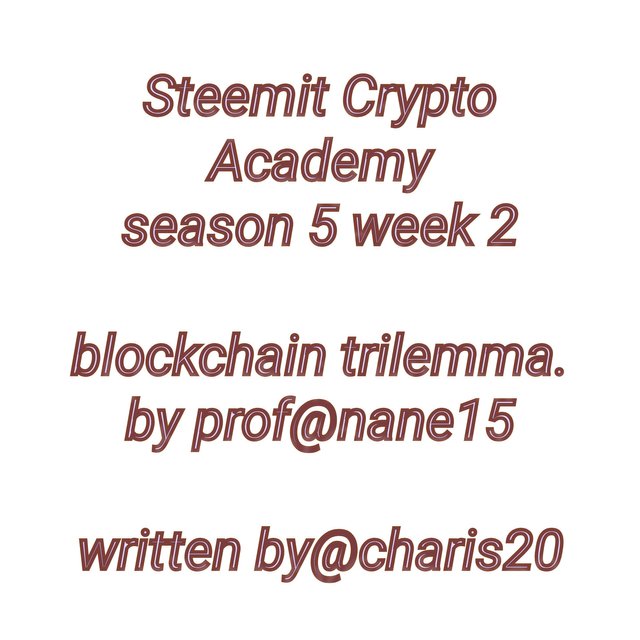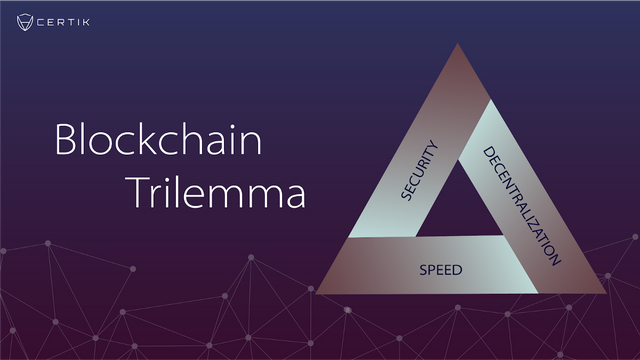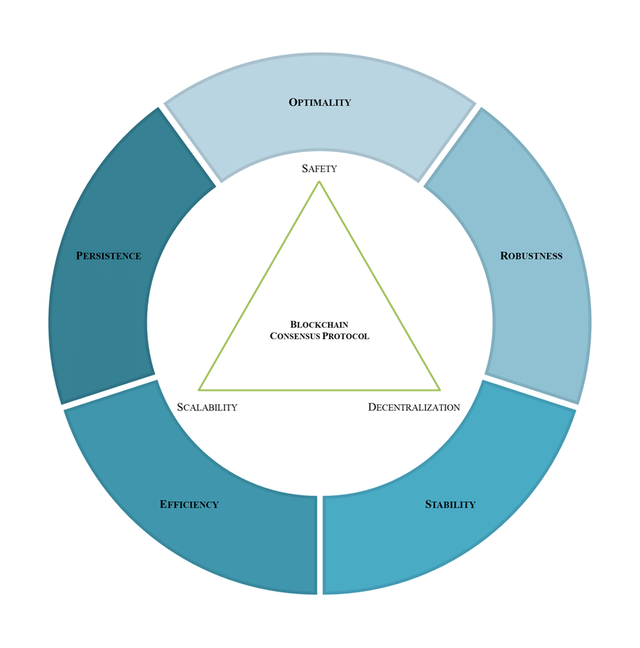Blockchain Trilemma For Professor @nane15

Image with imarkup
Helo steemians, nice to join the beginners class for this week again.
QUESTION 1
Explain in your own words what the Blockchain Trilemma is ?
The technology underlying decentralized blockchain networks is light years ahead of its time. Theoretically, we understand how such networks should work and what purpose they should serve. However, when it comes to putting theory into practice, developers struggle to create blockchains that have all three of the proposed fundamental features.
The advent of blockchain technology has resulted in significant changes in a wide range of activities. It has made the exchange of monetary values and information very transparent and secure by utilizing a public ledger (blockchain) comprised of distributed nodes all over the world. We can now do many things online and offline in a decentralized manner without the involvement of any intermediary or centralized authority thanks to the blockchain network. The blockchain has proven to be a more efficient and cost-effective method of disseminating information around the world. The use of cryptocurrencies is the most common application of blockchain technology. The financial world has been decentralized as a result of this.
Put simply, the blockchain trilemma is a concept invented by Vitalik Buterin that offers a number of three main issues developers face when building blockchains. Creators are often forced to sacrifice one “aspect” for the benefit of the other two.
We have seen that Blockchain technology is developing faster and faster every day. We have three main characteristics of the blockchain network. The three characteristics together raise the question of the “blockchain trilemma”. They include scalability, decentralization, and security and are made up of the blockchain trilemma. This idea of the trilimma blockchain was conceived by the founder of Ethereum, Vitalik Buterin. The term refers to the difficulty for a single network to exhibit all three main characteristics at the same time.
The Bitcoin and Ethereum networks are currently the most popular blockchain networks, and both seek to solve some of these problems using a variety of technologies. As far as the Bitcoin network is concerned, using Proof of Work (PoW) has become a very secure and decentralized network, and it will be very difficult for the network to solve the blockchain trilemma. The main issue is scalability. Scalability is a very pressing issue in the Bitcoin network due to the POW consensus mechanism, as miners must complete complex tasks before blocks can be verified.
Like the Bitcoin network, the proof-of-stake consensus mechanism is not scalable, but it reduces scalability issues. Another important part of the blockchain trilemma that tends to be problematic for most POS networks is decentralization.
Scalability is perhaps the most problematic feature to integrate into modern blockchain networks. Many projects claim to have reached this stage, but in fact none of them can support a large user base. A transaction throughput (TPS) of 6,000 can work if hundreds of nodes verify transactions for 50,000 active users, but what if you need to support millions of users simultaneously on the same network?
Decentralization is the first and simplest feature implemented in a blockchain network. At the end of the day, you just need to make sure that there is no central authority managing the system. But how does a blockchain work without a central entity?
You may already know this story. But let's remember the context. In decentralized blockchains, also known as unlicensed networks, miners contribute by verifying transactions. Their motivation is to receive transaction fees that other users have to pay.
Last but not least is security. Without it, the blockchain would be completely useless. Because everyone has a chance to break and even manipulate records.
The main reason that blockchains are less secure than centralized databases is that decentralized technology is also open source. Since every hacker can read the code, they can spend countless hours figuring out what kind of exploit they can perform.
Security is the only fundamental element required for the functioning of a blockchain network. Without protection, an attacker could take control of a significant portion of the
nodes or tamper with the
registry data to disrupt the network.
QUESTION 2
Is the Blockchain Trilemma Really a Trilemma?
Trilemma: Three is considered a trilemma if it proves very difficult to occur simultaneously. There is room for further improvement in the blockchain network. With the advent of blockchain networks, most of them are really close to overcoming the problem of collectively applying three key characteristics to the network. There is no confirmed evidence to support the concept of the blockchain trilemma.
I think the blockchain trillemma is something that can be resolved, even though no current blockchain network has fully succeeded in it. I firmly believe that this is just a term formulated to indicate the importance of these three main characteristics and how difficult it seems for them to work together simultaneously.
QUESTION 3
Define the following concepts in your own words: A. Decentralization B. Scalability C. Blockchain Security
DECENTRALIZATION
The blockchain is a public ledger, and all nodes connected to the network have access to the blockchain's historical data. All of the nodes that are linked together serve as reference points for one another. If a single node's data contains an error, the rest of the nodes can be used to correct the error. This prevents any node from modifying its data. The speed of transactions or block validation is usually determined by the number of nodes that validate the blocks. It will take longer to reach a consensus if the number is higher than if it is lower. The various blockchain networks use mechanisms to facilitate network decentralization. They are known as consensus mechanisms, and the block validation is dependent on which one is used. The Bitcoin network employs the Proof of Work Consensus mechanism.
The blockchain network is founded on the principle of decentralization. Decentrlization shifts decision-making from a central authority to the distributed networks of the blockchain. Because of decentralization, everything on the blockchain is transparent and secure. Blocks are generated for the transfer of assets among peers without the interference of any public entity.
A block is validated with the POW if a miner solves a complex problem. The generated blocks are then used for transactions. The POS, on the other hand, has members who are known as validators. The validators are the network's highest-level stakeholders, and they vote to confirm the generation of blocks. Both consensus mechanisms contribute to network decentralization, but it is clear that the Bitcoin network, which uses the POW consensus mechanism, is more scalable than the Ethereum network, which uses the POS consensus mechanism.
SCALABILITY
The bitcoin network's proof of work takes approximately 10 minutes to verify a block, implying that it can only perform about 6 transactions per second, whereas proof of stake blockchains can perform over 1000 transactions per second. Most blockchain networks typically sacrifice decentralization in favor of scalable transactions. The EOS network is a prime example of this conundrum. It can confirm over 4,000 transactions per second and plans an upgrade that will allow it to confirm millions of transactions per second, but the issue is that the network focuses less on the decentralization aspect in order to increase its scalability.
Scalability is a critical component of blockchain technology. The performance of a network's speed when it comes to verifying transactions is defined as its scalability. A highly scalable network can handle more transactions per second. A network's scalability is typically determined by the consensus mechanism used and the number of nodes required to validate blocks.
SECURITY
Blockvhain network security indicates how vulnerable your network is to attack. There have been many hacking scandals in the crypto space, all related to the instability of some networks. Security is very important in blockchain and should be given the utmost attention in any blockchain project. Security largely depends on the project code and the consensus mechanism used. There are many examples of blockchain fraud that occurred as a result of source code manipulation, indicating that the source code of a project must be kept secret to avoid manipulation. Various blockchain networks also use consensus mechanisms to determine how blocks are verified. Blockchain technology is well known for its high security. For example, in the Bitcoin network, a hacker needs to be 51% verified by other nodes before manipulating data, which is very difficult to achieve. Other networks trade security in exchange for scalability and decentralization. Now, as you know.
Scalability is a critical aspect of blockchain technology. The scalability of a network is the performance of the network's speed when it comes to verifying transactions. A highly scalable network has a higher number of transactions per second. The scalability of a network is typically determined by the consensus mechanism used and the number of nodes required to validate blocks.
QUESTION 4
Based on your knowledge, explain at least two viable solutions to the challenges posed by the Blockchain Trilemma.
We have seen that it is not an easy task to create a blockchain that is decentralized, scalable, and secure, as one is sacrificed in the process. However, in today's innovative world, developers have been looking for ways to either get through or around the problem. I'll go over two of them in more detail below;
Solutions for the first layer
These solutions attempt to solve the problem by going straight through it. It entails directly attempting to solve the trilemma on the blockchain in its development protocols.
The Solana blockchain, for example, claims to have solved the trilemma. The Proof of History and Proof of Stake consensus protocols were used in this blockchain. It is also highly scalable, with the ability to process up to 50,000 transactions per second. The blockchain is secure because of its consensus mechanisms.
However, because the blockchain is dependent on the Solana Foundation, which is a single entity, critics argue that it is not fully decentralized and thus does not solve the trilemma. However, as the blockchain becomes more decentralized, it will be able to confidently claim that it has solved the trilemma.
Solutions for the second layer
Another way around this is to go through second layers. That is, we solve a problem on the blockchain by using something other than the blockchain. A sidechain is an example of such a solution. Sidechains are commonly used in blockchains that are decentralized and secure but not very scalable.
When there is a lot of traffic on the blockchain, sidechains are used as an alternative route. They process transactions at extremely fast speeds, allowing them to process so many per second. As a result, their scalability. This will allow a blockchain to solve the blockchain trilemma.
CONCLUSION
I am confident that the blockchain trilemma will become a thing of the past as new projects emerge with the primary goal of addressing challenges that previous blockchains were unable to address. The Ethereum foundation has been working hard on this, as they have yet to launch the mainnet of Ethereum 2.0, which will solve the blockchain trilemma. Solana, Polkado, Cardano, and other emerging blockchain networks are also doing a great job of correcting any hiccups they may have encountered while solving this trilemma. Thank you for taking the time to read this.
My profound appreciation to prof@nane15 for putting this together.

